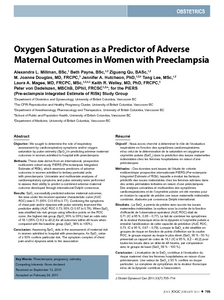Millman, AL; Payne, B; Qu, Z; Douglas, MJ; Hutcheon, JA; Lee, T; Magee, LA; Walley, KR; von Dadelszen, P
(2011)
Oxygen saturation as a predictor of adverse maternal outcomes in women with preeclampsia.
Journal of Obstetrics and Gynaecology Canada, 33 (7).
pp. 705-714.
ISSN 1701-2163
https://doi.org/10.1016/S1701-2163(16)34955-6
SGUL Authors: von Dadelszen, Peter
![[img]](https://openaccess.sgul.ac.uk/107533/1.hassmallThumbnailVersion/millman%20-%20jogc%20-%20SpO2%20-%202011.pdf)  Preview |
|
PDF
Published Version
Available under License ["licenses_description_publisher" not defined].
Download (367kB)
| Preview
|
Abstract
OBJECTIVE: We sought to determine the role of respiratory assessment by cardiorespiratory symptoms and/or oxygen saturation by pulse oximetry (SpO2) in predicting adverse maternal outcomes in women admitted to hospital with preeclampsia. METHODS: These data derive from an international, prospective multicentre cohort study, PIERS (Pre-eclampsia Integrated Estimate of RiSk), which assesses predictors of adverse outcomes in women admitted to tertiary perinatal units with preeclampsia. Univariate and multivariate analyses of cardiorespiratory symptoms and pulse oximetry were performed to assess their ability to predict a combined adverse maternal outcome developed through international Delphi consensus. RESULTS: SpO2 successfully predicted adverse maternal outcomes; the area under the receiver-operator characteristic curve (AUC ROC) was 0.71 (95% CI 0.65 to 0.77). Combining the symptoms of chest pain and/or dyspnea with pulse oximetry improved this predictive ability (AUC ROC 0.73; 95% CI 0.67 to 0.78). When SpO2 was stratified into risk groups using inflection points on the ROC curve, the highest risk group (SpO2 90% to 93%) had an odds ratio of 18.1 (95% CI 8.2 to 40.2) for all outcomes within 48 hours when compared with the baseline group (SpO2 98% to 100%). CONCLUSION: Assessing SpO2 aids in the assessment of maternal risk in women admitted to hospital with preeclampsia. An SpO2 value of ≤ 93% confers particular risk. The symptom complex of chest pain and/or dyspnea adds to the association.
| Item Type: |
Article
|
| Additional Information: |
© 2011 Society of Obstetricians and Gynaecologists of Canada. Published by Elsevier Inc. All rights reserved. Made available with permission from the publisher. Contact publisher for any further re-use. |
| Keywords: |
Adult, Chest Pain, Dyspnea, Female, Humans, Oximetry, Oxygen, Pre-Eclampsia, Pregnancy, Pregnancy Outcome, Prognosis, ROC Curve, Risk Factors, Humans, Dyspnea, Pre-Eclampsia, Chest Pain, Oxygen, Oximetry, Prognosis, Pregnancy Outcome, Risk Factors, ROC Curve, Pregnancy, Adult, Female, 1114 Paediatrics And Reproductive Medicine |
| SGUL Research Institute / Research Centre: |
Academic Structure > Molecular and Clinical Sciences Research Institute (MCS) |
| Journal or Publication Title: |
Journal of Obstetrics and Gynaecology Canada |
| ISSN: |
1701-2163 |
| Language: |
eng |
| Dates: |
| Date | Event |
|---|
| 1 July 2011 | Published |
|
| Publisher License: |
Publisher's own licence |
| Projects: |
| Project ID | Funder | Funder ID |
|---|
| UNSPECIFIED | Canadian Institutes of Health Research | UNSPECIFIED |
|
| PubMed ID: |
21749746 |
 |
Go to PubMed abstract |
| URI: |
https://openaccess.sgul.ac.uk/id/eprint/107533 |
| Publisher's version: |
https://doi.org/10.1016/S1701-2163(16)34955-6 |
Statistics
Item downloaded times since 06 May 2016.
Actions (login required)
 |
Edit Item |



